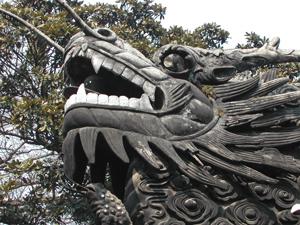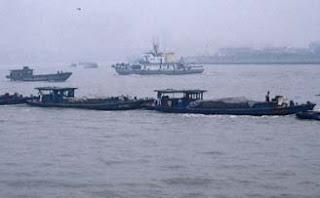
Dragon, Yuyuan Gardens, Shanghai
In the summer of 1995, we traveled to China, visiting Shanghai, Beijing, and Xian. In Beijing and Xian we had an official Chinese tour guide. In Shanghai, we were on our own. We visited an American friend who was living there while in a cooperative venture to build an auto repair shop in anticipation of the time when more people would own cars. At the time, the streets were still filled with bicycles and rickshaws, with the primary motorized vehicles being trucks and buses. When I returned to Shanghai ten years later, in 2005, the city had totally changed, with cars jamming every road, and double layered freeways connecting the far reaches of the ever growing city. Now, as I read my diary from the 1995 trip, and compare our experiences with my trip in 2005 and Sara Kras’s trip to China in 2011 (guest blog post Jan 9, 2012) I am amazed at the contrast. Here are some excerpts from our first day in Shanghai in 1995:Traffic
To begin with, it was arranged that the company driver would take us to the tourist office where we needed to get tickets for our next flight. We proceeded into central Shanghai, the driver dodging between buses, cars, pedestrians, bicycles, trucks and pedal carts. The streets are packed and driving impossible, but no one ever gets going fast enough to create any real damage in a collision–although we did see two bicycles run into each other. Everyone uses their horns constantly. David had a car come into the shop that had 6000 miles on it and needed to have the horn replaced because it was worn out! Bicycle riders included both men and women dressed to go to work–women often in stylish clothes. Although a few wore high heels, most had flat shoes. We saw few children–just a few babies strapped onto their mothers’ backs or young children riding on the bar in front of their parents’ bicycles.

Walkway along the Bund
The BundAfter leaving the tourist office, we set out on foot to meet a young Chinese girl, Chen Ci, and her father, acquaintances of our American friends, who had offered to show us around. We had arranged to meet them at the door of the Peace Hotel on the Bund. [The Shanghai Bund, on the banks of the Huangpo river, was the financial hub of East Asia at the end of the 19th and beginning of the 20th centuries, with imposing structures that housed banks and foreign offices. Today it is a commercial center with a walk and park along the river.] At first we walked along city streets, where people spilled out onto the sidewalk in front of small shops. They were cleaning vegetables, washing clothes and dishes, sitting on chairs and playing cards, tending small gardens planted around the trees next to the street. Our route was clearly not one that foreigners usually took and eyes followed our every move. At the end of the street we found ourselves at the river about a half mile south of the Bund, so we walked north until the riverfront became a park. In the river were a variety of watercraft–from sightseeing boats and ocean going vessels to barges and sampans. The weather was so smoggy and overcast that everything disappeared into a gray Turneresque mist not far from shore.

Watercraft in the Huangpo River
Huangpu ParkWe found Chen Ci and her father as planned. Chen Ci, age 7, had been learning English at school since she was two and was amazingly fluent, unlike her father, who had studied Russian as a student. We walked with them along the Bund to Huangpu Park. Apparently, during the colonial era, this was a park for the British only and a had a now famous sign at the entrance that said “No dogs or Chinese allowed.” Chen Ci (pronounced Chen Suh) was so excited by our visit she could hardly stand still. As we passed statues of the first mayor of Shanghai and of Mao, she insisted on imitating their heroic poses and having us take her picture.

In the Yuyuan Gardens
Yuyuan Gardens
After the park, we headed for the Yuyuan gardens, a maze of traditional buildings and waterways. [The Yuyuan gardens, built in the 16th century for a government officer of the Ming Dynasty, were restored in the 1950's and opened to the public in 1961.] When we arrived, we found ourselves in an ornate alleyway with red-painted shops on either side. It led to another alley and finally out to a courtyard around a small lake crossed by a zigzag bridge. There were various food stalls around the water, but Chen Ci’s father led us to a stairway up to a second floor restaurant overlooking the lake.
The waitress brought glasses with printed napkins tucked inside, which Chen Ci promptly put into her bag as a souvenir. The menus were in Chinese so we let Chen Ci and her father do the ordering. When they asked if we wanted one or two dumplings, we said two, thinking that meant two apiece. Instead, we got two round trays with twelve dumplings per tray! Each noodle wrapped dumpling was filled with pork and had been steamed. You put the whole slippery dumpling in your mouth (after you’ve grabbed it with your chopsticks), bite down, and the hot pork juices squirt into your mouth. The dumplings came with vinegar/soy sauce, but also tasted good with the red sauce that came with the beef. We also got a plate of tiny shrimp and Chinese peas. We drank green tea, which Chen Ci kept pouring and wanting us to clink our glasses and say “kempe”, meaning “to your health.”

Zigzag bridge in the Yuyuan Gardens
After paying for lunch, we went across the zigzag bridge and into the Yuyuan garden where Chen Ci jumped on the rocks and posed beside statues for more pictures, chattering all the time. We briefly latched onto an English speaking tour group, whose guide said the rocks, which had been imported, were fastened together with some kind of rice paste. Then it was time to say goodbye. We found a taxi, showing the driver a printout of our friend's address to tell him where we wanted to go.